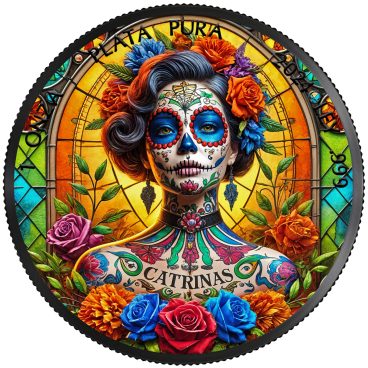This series of coins brings the ancient art of stained glass together with the celebration of the Dia de los Muertos. This type of art is increasingly being used in buildings, not only to decorate religious buildings but also for any type of modern decoration.

Dia de los Muertos Stained Glass 2024
The art of stained glass is the technique of creating decorative stained glass windows for churches, cathedrals and important buildings. This art combines the use of coloured pieces of glass, cut and assembled, with the aim of creating images or patterns that allow light to pass through, generating luminous and dramatic effects.
In Mexico, stained glass has not only been used in religious contexts, but has also evolved in the secular sphere, decorating historic buildings, palaces and private residences. Over time, Mexican artists adapted the art of stained glass, incorporating local themes such as pre-Hispanic motifs, indigenous flora and fauna, and scenes of mestizaje and everyday life.
Today, stained glass art in Mexico remains a vibrant artistic manifestation, both in its traditional form and in more contemporary versions, where artisans and artists explore modern techniques and more complex visual narratives. This art maintains a unique connection to light, colour and Mexican culture, and is notable for its ability to transform spaces through the play of light and shadow.
Hoy en día, el arte de la vidriera en México sigue siendo una manifestación artística vibrante, tanto en su forma tradicional como en versiones más contemporáneas, donde los artesanos y artistas exploran técnicas modernas y narrativas visuales más complejas. Este arte mantiene una conexión única con la luz, el color y la cultura mexicana, destacándose por su capacidad de transformar los espacios a través del juego de luz y sombra.

Your question has been sent successfully. You will receive a response in the near future.

Check your email for the confirmation message.
